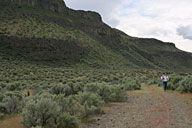The Seattle P.I.'s Hike Of The Week for last week featured the Blythe Lake area of the Columbia National Wildlife Refuge, in central Washington. The article contains the following warning: "Be on the alert for rattlesnakes and ticks." Steve and I made the trip last weekend, and I will certainly wear boots instead of sandals if I ever go hiking in that area again.
The day was pretty nice, though the sky wasn't perfect, and we did experience a bit of rain later in the day. The drive from Seattle was pretty long, and we stopped by the Columbia river for lunch and to check out the petrified Ginko forest and interpretive center. I had been here some years before, but had not been able to see the forest at that time, so was interested to check it out. The "forest" itself, it turns out, is a barren area criss-crossed by several trails, where a number of petrified stumps of various tree varieties have been uncovered from the dirt - and then covered with big metal grates. These were interesting, but not exactly overwhelming, and did not make for very good photographs. So back to the interpretive center (about 2.5 miles away, overlooking the Columbia river), which is surrounded by many petrified logs, and I found it of far more actual interest. There are also some petroglyphs at the interpretive center; these were not intially at that location, but were found about a mile north and relocated.
Then on to the wildlife refuge and up to Blythe lake, a few miles down a gravel road. We started walking up an old, gated-off road. The weather was quite warm, and the area is fascinating - all scrubland with many basalt column ridges. After a while the dusty road (such as it was) gave way to dusty path, with brush encrouching from the sides. After a bit we came across a picturesque, fairly flat rock right beside the trail, and I decided to get Steve to pose for a photo on it. That resulted in the exchange detailed at the top of this page, and took the "be on the alert for rattlesnakes" warning out of the abstract.
Three snake encounters further - all right beside the trail, mostly quiet and unobserved as I passed but startled into movement by Steve following behind - and I decided that I was ready to go back to the car. Steve agreed, though frankly it was obvious that he was humoring me. He spent the walk back to the car desperately looking for more snakes to try to get a photo. He did in fact get another chance, but when he bent down to take a photo of this latest snake, again, right beside the trail, another one, even closer, was startled away, causing Steve to lose concentration and fail to photograph either snake. Grand total: six snake encounters, although I myself only actually saw two of them, and I could not tell you for sure what kind of snake they were. One of the two, however, I think looked much like one shown on a page I found by Alan Bauer, which he claims is a Western Rattlesnake. (Larger photo available.)
So we then spent our time driving around seeing different parts of the wildlife refuge. There is a road that crosses diagonally through the refuge; at the northern end it sports some nice views of the earthen dam there, showing the lake and islands above the dam contrasting with the dry scablands below. There is also a viewpoint further south on that road which seems to give a fairly dramatic view over the refuge, but we didn't arrive there until after the good light was gone.
Driving back toward Seattle, we were heading pretty much due west and the sun lowered right into our eyes. To make things worse, it started raining a little; the combination made it very difficult to see anything ahead, so we ended up pulling off the road and waiting for the sun to no longer be a problem. While waiting, we saw a beautiful, horizon-to-horizon rainbow (double rainbow in parts). After the sun went behind clouds, we resumed our trip back, finding a place to drop south of the Crab creek, and drove along very close to some impressive, steep hills. The earlier glimpses we had seen of these hills were pretty interesting, but there was very little light by the time we got to this area, so we didn't manage to take any photos.
|

















